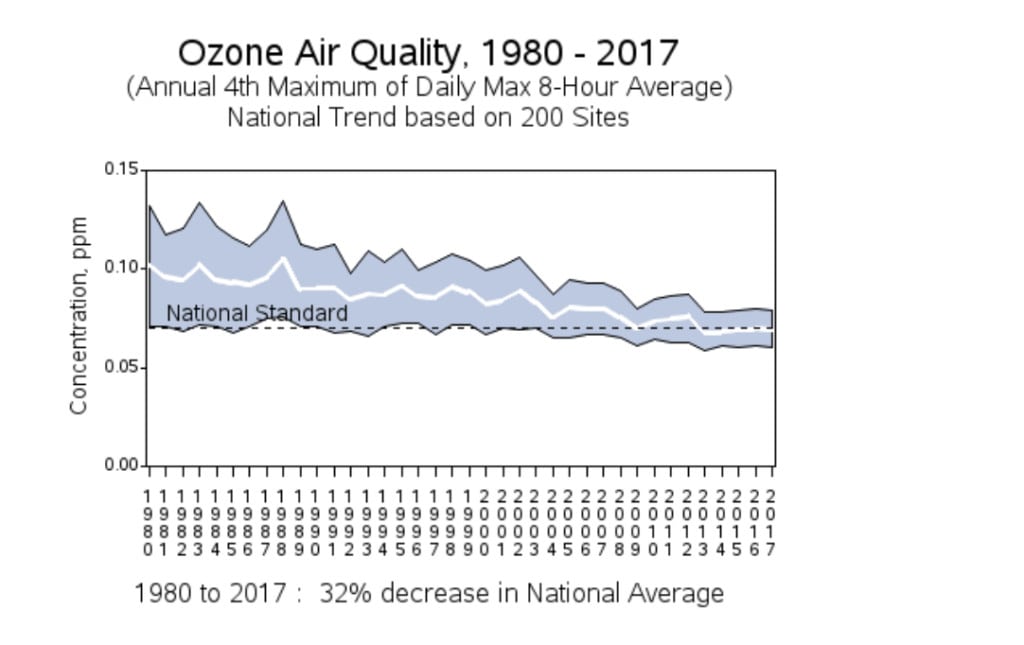The Environmental Protection Agency (EPA) does not intend to revisit national ambient air quality standards (NAAQS) for ozone that the Obama administration issued in 2015, a court filing shows.
The agency said in its final status report submitted to the U.S. Court of Appeals for the D.C. Circuit on August 1 that it has reviewed the 2015 rule governing state-implementation of primary and secondary NAAQS for ozone—also known as smog—from mobile or stationary sources, but “determined that at this time, EPA does not intend to revisit the 2015 Rule.”
The 2015 ozone rule tightened limits of ozone from 0.075 parts per million (ppm) of ozone averaged over eight hours, as set by the Bush administration in March 2008, to 0.070 ppm. The rule, which followed a proposal to revise standards to a range of 0.065 ppm to 0.070 ppm, drew ire from both industry and environmental groups. It was challenged in federal court.

But before the D.C. Circuit heard oral arguments in Murray Energy Corp. v. EPA (No. 15-1385), a case involving consolidated petitions for review of the 2015 rule, the D.C. Circuit in April 2017 granted the Trump administration’s motion to hold the case in abeyance until the agency could review the rule following the presidential transition.
On August 1, however, the court lifted the abeyance and ordered parties involved in the case to submit motions to govern further proceedings by August 22, 2018.
In its filing on August 1, the EPA said it has been “intensively considering and developing a new approach” for the EPA’s program for NAAQS to comply with two high-level directives from the Trump administration.
The first is an April 2018 memo issued by President Trump that directs the EPA administrator to evaluate whether the agency is complying with “applicable procedural, scientific and technical requirements pertaining to its periodic five-year NAAQS reviews under 42 U.S.C. § 7409(d).” The president specifically ordered the EPA to evaluate compliance with provisions in accordance with “advice” it received from the Clean Air Scientific Advisory Committee (CASC), a statutorily related NAAQS advisory panel. On July 27, the EPA issued a request for nominations of experts for the committee’s ozone review panel, calling for submissions by August 17, 2018.
The second is a May 9, 2018, memo issued by former EPA Administrator Scott Pruitt, which the agency describes as a “Back-to-Basics” process for reviewing NAAQS. In that memo, Pruitt said the agency is committed to completing the periodic five-year NAAQS reviews in a “timely fashion.” But it also urges the CASC to review “the relative contribution of natural and anthropogenic activity,” for ozone, including additional and background concentrations of ozone and other pollutants. Since the memo was issued, the EPA says it has issued a public call for “scientific and policy-relevant information” as well as for information “related to adverse effects which may result from various strategies for attainment and maintenance of NAAQS.”
If and when this information is submitted, the EPA will integrate it into its forthcoming review of the ozone NAAQS, which it intends to complete by 2020.
In that review, the EPA will also likely re-evaluate the extent to which an administrator can or should consider levels of background ozone when choosing a standard. “Because the rationale of the 2015 Rule focused on the factual question of whether background ozone would interfere with attainment of the 2015 NAAQS, EPA did not resolve the question of whether raising the NAAQS to accommodate background ozone could be a permissible reading of the Clean Air Act under step two of the Chevron analysis,” it noted.
But for now, the EPA will stick with the 2015 rule, owing in part to the D.C. Circuit’s recent decision on the EPA’s ability to revoke previously promulgated NAAQS, and “the importance of certainty” for states and the regulated community.
“In light of all these considerations, while EPA officials in the current administration may have supported making different judgments about the significance of background concentrations of ozone and how to judge what standards are requisite to protect public health and welfare, the Agency at this time does not intend to revisit the 2015 Rule,” it said.
—Sonal Patel is a POWER associate editor (@sonalcpatel, @POWERmagazine)










